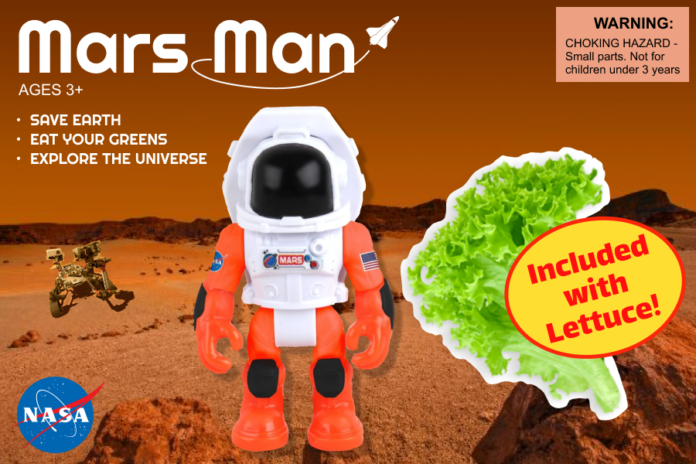The transgenic lettuce contains a fusion protein that can counteract the loss of bone density in microgravity
By SONORA SLATER — science@theaggie.org
Our bodies were made to interact with Earth’s gravitational pull. When astronauts take part in long spaceflights and encounter extended microgravity, there are side effects that occur — specifically, loss of bone density.
Human bones are balanced between growth and resorption, or breakdown, which allows the body to react to injury or other outside factors. Spending time in microgravity disrupts this balance and causes astronauts to lose bone mass. Scientists have tried to solve this problem in several ways, such as by promoting exercise in space, supplementing astronauts with calcium and regularly injecting parathyroid hormone (PTH).
However, each of these methods have their limitations. Exercise isn’t enough to prevent bone loss on its own, calcium does not absorb well into the astronauts’ bodies and injections of any type are difficult in space because of low gravitation.
According to a recent press release, researchers at UC Davis in collaboration with the Center for the Utilization of Biological Engineering in Space (CUBES) have developed a new potential solution that avoids the limitations of the past: genetically modified lettuce.
Kevin Yates, a fourth-year Ph.D. student in the Department of Chemical Engineering at UC Davis and one of the researchers on the project, explained how they made genetically modified lettuce.
“We modified regular wild lettuce to produce the fusion protein PTH-Fc by inserting this gene into the lettuce,” Yates said. “The lettuce now, because it’s transgenic, produces [the fusion protein] in every cell of the plant.”
Yates went on to explain what exactly a “fusion protein” like PTH-Fc is.
“Essentially it’s two parts of two proteins,” Yates said. “The first is a part of the human parathyroid hormone, and we linked that to a part of a human antibody protein.”
According to Karen McDonald, a professor in the Department of Chemical Engineering at UC Davis, fusion proteins like PTH-Fc serve multiple purposes, including making the protein more stable when it’s produced in the plant and when it enters the bloodstream, as well as making the drug easier to purify from plant extracts.
So, with this purpose and functionality in mind, why lettuce?
“As far as transgenic plants are concerned, lettuce has never been a great platform,” said Somen Nandi, an adjunct professor in the UC Davis Department of Chemical Engineering and one of the researchers on the project. “But they are currently growing lettuce in the International Space Station, so this way we don’t have to reinvent the wheel because transgenic lettuce doesn’t necessarily have to grow any way different. That’s why we’re piggybacking off of a known thing that astronauts are familiar with.”
According to Yates, the researchers are hopeful that astronauts can acquire PTH-Fc orally by simply eating the lettuce, so the dynamic of how lettuce grows is another benefit of using the plant.
“Lettuce, as soon as it emerges from the soil, it’s edible,” Yates said. “You don’t have to wait for it to grow a fruit or something like that. Most of the plant, when it’s younger like that, is edible.”
Astronauts dosing themselves with the drug by eating lettuce leaves is the ideal scenario, but if that doesn’t end up working, there’s a plan B: extracting and purifying the drug from the plants.
“Plan B would be that we would grind up the lettuce and extract our fusion protein,” McDonald said. “Then we could take it through the traditional chromatography and filtration steps that occur here on Earth — small scale, of course.”
Even if eating the lettuce directly doesn’t work, purifying the drug from transgenic lettuce still provides a variety of benefits as a solution, according to the press release. For one, a mission to Mars could take several years, and growing food apart from prepackaged meals can be good for the mental health of astronauts.
“It gives a lot of morale boosters or psychological boosters if the astronauts see the green growing and they can use that as a food,” Nandi said.
Looking forward, research may move toward evaluating how much of the drug the plants can produce, which leaves contain the most product and the best time to harvest the leaves, as well as experimenting with growing other crops like tomatoes, rice and potatoes in low-resource space conditions.
Nandi explained that while their research is focused on the goal of space travel, the information they learn about resource utilization in low-resource conditions could be used to help solve problems on Earth as well.
According to Nandi, if medicinal drugs like PTH-Fc can be shown to successfully enter the bloodstream through consumption, other forms of transgenic crops could potentially be developed to carry other medicines. Seeds from these crops could then be sent to low-resource countries to be grown, distributed and eaten.
McDonald elaborated on the broader applicability of biological solutions.
“Obviously, Mars is the extreme in low-resource environments,” McDonald said. “But using plants is a really valuable approach even on Earth, because many parts of the world are very proficient at growing plants, and it doesn’t necessarily require a very highly trained workforce.”
As NASA prepares to send people to the moon again, potentially in 2024, and to Mars, potentially in the 2030s, Yates said that various groups in CUBES are also working on other biological solutions to the challenges astronauts who undergo long spaceflights face.
“It’s not just lettuce on its own,” Yates said. “It’s other plants, it’s microbes, it’s all sorts of really cool things. I think that you’re going to need biological solutions, and particularly those based on plants, in order to eliminate or mitigate a lot of the serious challenges that humans are going to face in deep space.”
Written by: Sonora Slater — science@theaggie.org




